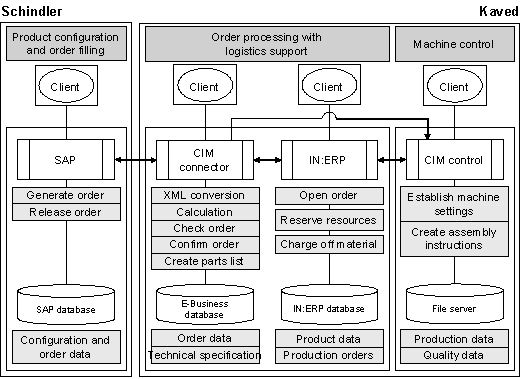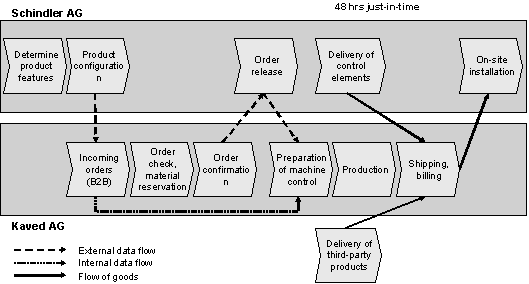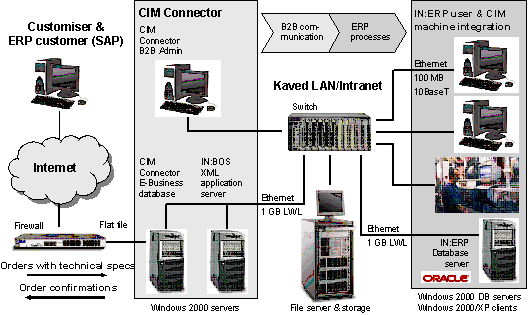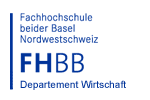Mass customisation through B2B integration at Kaved AG
Kaved AG, a subsidiary of Dätwyler Holding, mass-produces cabling systems for the engineering, instruments and elevator industry. Kaved is a strategically important supplier to the Schindler Group. The value-enhancing partnership between Kaved and Schindler is supported both by external integration of information systems and an internal network comprising an ERP system and computer-integrated manufacture. This form of e-business support enables machine production of complex and variable cabling systems for elevators. This has opened up enormous potential for increased efficiency.
Inhaltsverzeichnis
1. The company2. E-Business strategy
Outsourcing
3. Integration solution
Business perspective, Business model, Mass-customising, Just-in-time, Cooperation, Process view, Processes, Quality assurance, Application view, Software solution, ERP system, CIM, Machine control, Commissioning, Technical view, System architecture
4. Implementation
5. Operation
Maintenance, Costs and Benefits, Costs, Profitability
6. Success factors
1. The company
This case study focuses on the view of the e-business solution operator, i.e. from the standpoint of Kaved AG. This chapter begins by describing the company and its services. The following chapters treat the e-business solution and the important partners linked to it.
Background:
Kaved AG was founded in 1967. From its inception, the purpose of the company has been in the manufacture of cables for the Swiss engineering and instruments industry. In 1972, Dätwyler-Holding of Altdorf took over Kaved as a fully-owned subsidiary. Kaved’s business activities were subsequently extended to include services for Dätwyler. Kaved gained access to Dätwyler expertise through the takeover. Kaved has supplied manufacturing and logistics services to the elevator industry since 1995.
The Dätwyler Group today employs some 4,200 people worldwide and generated turnover in excess of one billion Swiss francs in the last financial year. Dätwyler is a diversified industrial group. Its divisions are: Cables+Systems, Rubber+Plastics, Precision Tubes, Pharmaceutical Packaging and Technical Components. Kaved is part of the Cables+Systems divisions and has a workforce of 100.
Kaved nurtures a corporate culture that promotes top performance. It sees itself as a value-enhancing partner offering its customers the added value decisive to their success. Its success factors are customer focus, competent employees and the deployment of cutting-edge technology.
Industry, markets and target groups:
The machine and instruments industry is characterised by strong cyclical fluctuation in orders, great cost pressure and intensive competition. Demand exists for customised products in very small to medium-sized batch sizes. Material selection and the manufacturing process have been optimised to a great extent. However, administrative order processing such as ordering, order confirmation, invoicing and order-data archiving have been largely ignored. In this area in particular, modern technologies like B2B and the internet offer considerable savings potential.
In terms of new investment, the elevator business is subject to fluctuations in building activity in the various markets. Added to this is a strong rise in demand for modernisation of exiting elevator facilities. Great cost pressure applies to this business, too. Suppliers must do a great deal of preliminary legwork in developing expertise, production plants and IT. The market demands of suppliers extremely short lead times and unconditional schedule effectiveness. In addition to these essentially qualitative requirements, customers’ cost objectives are also clearly brought to bear. Suppliers like Kaved are thus forced to save costs by perpetually streamlining the materials and production process.
Schindler is the world’s second-largest elevator manufacture and Kaved’s key customer. Per contra, Kaved is one of Schindler’s main suppliers. Batches of size 1 (per elevator) are produced. The great complexity and extreme variability of cabling systems place very high requirements on the entire value added process and its management.
Corporate vision:
Kaved is the leading manufacturer of mass-produced cabling systems for the entire Swiss industry and the global elevator business. In the long term, the company seeks to secure its strong competitive position by the extra utility it offers its customers. The lead over its competitors is founded on Kaved’s expertise, IT solutions and logistics competence.
2. E-Business strategy
The development of Kaved AG’s e-business strategy was strongly influenced by its cooperation with Schindler. Schindler wanted to outsource the non-core part of the value chain for its elevator business and to transfer the entire provision of installation components to a sub-supplier. By accepting this challenge, Kaved entered a newly-created niche market. Its decision to introduce its own comprehensive e-business solution coincided with the step.
Importance of e-business in the corporate strategy:
Kaved pursues a range of strategic corporate objectives as part of its e-business strategy. By networking its customers, additional benefits are generated for them, resulting chiefly in a reduction of the cost of order-processing, consistently high quality and short delivery times. The use of e-business also cuts order-processing costs for Kaved. Short lead times reduce the cost of capital tie-up.
E-business is accorded a significant role in Kaved’s corporate strategy. It bolsters the company’s competitiveness and has positive effects on costs and productivity. In the case of cable manufacture, e-business in conjunction with CIM plays a special role as an “enabling technology”. That’s because rational machining of complex cabling systems is only possible with e-business support.
E-business application areas in the company:
The IN:ERP ERP system used by Kaved contains various e-business applications, such as CRM and SCM modules and external integration of customers via an extranet (described in detail in chapter 3). Already, 70 per cent of sales are processed electronically and input directly into the CIM process as orders.
Thus far, Kaved has used electronic marketplaces solely for information gathering. It helps in evaluating raw materials and tracking down favourably-priced suppliers. Other buy-side e-business solutions have yet to be instituted at Kaved.
Kaved has no intranet solution of its own; the company uses the Dätwyler Group intranet.
Kaved’s website is used primarily to present corporate and product information. In future, the website will be used to provide customers with information about the raw materials the company uses. In this way, the customer can find out which materials Kaved can supply at favourable terms and can take the information into consideration as early as the development phase.
Partners:
ERP supplier and IT partner
Informing AG, in nearby Stans, provided the ERP system and the integration components based on it. Informing has supplied ERP systems since 1988 and has 40 employees. Its main IN:ERP product is classified as a ERP II system.
IN:ERP is targeted primarily at medium-sized enterprises with from 50 to 500 employees. Informing markets its products chiefly in German-speaking countries. Its business is founded on customer confidence in the entire product lifecycle. As a rule, Informing’s customer partnerships endure many years.
Business partner
As already mentioned, the Schindler Group, based in Ebikon near Lucerne, is a key Kaved account and is the leading Swiss and world number-two manufacturer of elevator facilities.
As a sub-supplier of cabling systems, Kaved undertakes part of the value added process for Schindler. Schindler enters long-term partnerships with this type of key strategic supplier. The supplier aims to reduce drastically development costs, delivery deadlines, manufacturing and logistics costs and the cost of installing and operating elevators.
3. Integration solution
This chapter describes Kaved’s e-business solution from the perspectives of business, process and use. Fundamental technical principles are also treated briefly. In the forefront are the aspects of integration. Fig 3.1 sketches the overall solution in chart form.
Business perspective:
In answer to the challenges posed by a market typified by overcapacities, the business strategy employed by the Schindler Group aims to realise high productivity gains by integrating system sub-suppliers into the value added process and thus reduce logistics costs (cf. Partners section in chapter 2). Under the arrangement, Kaved is responsible for the complete production of cabling systems needed to control elevators, light shafts and power equipment.

Fig. 3.1: Integration solution overview
A huge potential for efficiency is utilised in the industrial production of completely installation-ready cabling systems. Logistics services accompanying the production of cabling systems serve to supply all electrical installation and management components as a complete package of services.
The complexity and variability of cabling systems place demanding requirements both on inter-company e-business integration and internal IT networking. Exchanging and processing the data needed is so costly and time-consuming that rational production of cabling systems only became possible once suitable IT support was put in place. External integration has so far only been realised with Schindler. Links to other customers are in preparation.
Kaved’s e-business solution enables mass customising of cabling systems and supports logistics in the entire materials flow. It enables customers to refer to customised cabling systems and take advantage lead in efficiency offered by industrial manufacture. Short lead times permit just-in-time production. Delivery of completely installation-ready and commissioned cabling systems occurs reliably 48 hours after order release.
The high investments by Kaved in customer-specific production plant, IT systems, consulting, engineering and training are secured over a number of years by a cooperation agreement between Schindler and Kaved. The basis of this agreement is the production of cabling systems and other services.
Process view:
The cable production process, as depicted in fig. 3.2, is triggered by order criteria input online by Schindler’s sales organisations entering a central customiser. Key order criteria are the type and size of the elevator system and the dimensions of the elevator shaft. The customiser generates technical product specifications from this data. Armed with these specifications, Kaved is able to produce the components and system elements.

Fig. 3.2: The value added process at Schindler and Kaved
Schindler transmits orders and their technical specifications to Kaved by EDI. From the specifications, Kaved establishes the materials required to manufacture the products ordered (shaft installation, suspension cables, machine-room cabling etc.) and reserves them for the order. Up to one hundred items are required for each order.
Kaved performs a price calculation based on the materials and steps required. If the calculation concurs with the price transmitted by Schindler, an electronic order confirmation is subsequently sent to Schindler. Price deviations require clarifications and manual intervention. Following order confirmation, the resources needed for production (materials, machines, personnel) are scheduled.
Schindler releases the order once it has received the order confirmation. As soon as the go-ahead is given, Kaved enters the order in its daily schedule and books from stock the material required. The product specifications produced by the customiser are reprocessed for manufacturing. From these specifications, information is generated on machine control (settings, processes), quality control (inspection characteristics), labelling of assembled components (bar code) and dispatch.
[Quality assurance] Kaved assembles the cabling systems in zero-defects quality. Ongoing measurements during production ensure that components match the specifications.
The production process occurs at Kaved while Schindler provides the control system. Together with the assembled cable system and other third-party products, it is packaged into a complete installation set ready for use on the construction site. Kaved delivers the installation set by carrier to the various national companies within 48 hours of the order being released.
In concluding the order, the production data are read back into the ERP system. A quality file is created for all components produced containing all quality-relevant data. The quality files are archived together with the order details. Finally, the buyer is invoiced in the conventional manner.
Application view:
The e-business solution at Kaved is based on the IN:ERP ERP system. Kaved uses the basic Purchasing, Sales and Stock Management ERP modules and the extended Production Planning and Control (PPS), Product Data Management (PDM) and Operation Data Capture (BDE) ERP modules.
The standard IN:BOS module, represented by an application server for ERP web services, is also used to integrate business partners. IN:BOS comprises the complete business logic of the ERP system and is accessible to external systems. It also controls access authority. IN:BOS supports internal integration and enables the ERP system to be used with an HTML browser to open orders, articles and more.
[CIM] Schindler’s product customisers transmit the generated product specifications in what are known as “flat files”. Various data formats had to be defined in the run-up. A CIM Connector, specially designed for the company, is available at Kaved to process incoming electronic documents. Orders sent by the customisers are stored temporarily in an e-business database. From there, the orders are retrieved manually and subsequently reprocessed in the CIM Connector (cf. fig. 3.3).
The CIM Connector features its own business logic containing the order type, order logic and a range of rules for each product line. These parameters are used to generate price calculations, manufacturing bills of materials and production offers from incoming schedules and commercial product characteristics. By defining data and rules in the forefront, those products for processing using the solution can be specified for each customer. In this way, other customers can be integrated.
The B2B Admin application is available for reprocessing administrative order data. It is part of the CIM Connector and represents incoming orders and the results of checks on orders received. Finally, B2B Admin creates order confirmations. To reserve the material once the order is confirmed, IN:BOS opens the production orders with their corresponding documents (manufacturing bills of materials, machine data, quality files etc) in the ERP system. Depending on Schindler’s scheduling, a definitive release for production is given there.
There is internal integration between the CIM Connector and production plant control at Kaved (Fig. 3.1). The technical files originating from the customisers are transmitted unchanged to the machine control system once an order is released. This interprets the information in the files and converts it into information giving machinery settings and concrete assembly instructions. Production staff receive these instructions on their monitors to guide them step-by-step through their activities, simplifying considerably machine control and the coordination of manual operations. In this way, outstanding efficiency can also be achieved in the production of one-off pieces. At the same time, the precise process control serves the quality assurance integrated into the production sequence.
Once production is complete, the installation sets are commissioned, controlled by the Stock Management basic ERP module. Stock management supports logistics in the entire flow of materials. The cabling systems produced are first individually packed and bar-coded with labels printed once production is finished. The packaging units are sent by conveyor belt to the actual commissioning point where it meets with the Schindler control unit delivered just in time and any further third-party components. By “zapping” the bar code, the individual components in the order are recorded as commissioned and then prepared for shipping. An order can only be sent when all order components have been recorded in this way.
Technical view [System architecture]:
The e-business solution at Kaved is based on the multilingual IN:ERP ERP system with its three-tier architecture. The business logic can be modelled independently of the technology used. Business objects and work flow components are available for this purpose. Programming is in the object-orientated SmallTalk language.
Further levels contain the data keeping and presentation. Each level can be customised independently of other levels and without affecting the release capability of IN:ERP. An intermediate layer exists for database access so that the business objects do not access the database directly and other database systems besides Oracle can be supported.
IN:ERP is used from in-house workstations using “fat clients” on a local network (cf. fig. 3.3). A SOAP/XML interface can also be used to access all functions and information available in the ERP system (to support an HTML browser interface, for example, or for B2B and EAI integration). Flat files, converted in the CIM Connector into and out of XML format, are used to communicate with Schindler’s SAP system.
IN:ERP and IN:BOS run on a WINTEL platform (Windows operating systems with INTEL processors). The Oracle database system can be run under Windows or LINUX. Because of the complex order structures, IN:BOS for Kaved was augmented by a custom application, the CIM Connector. The CIM Connector contains the B2B Admin module that takes on price calculations and scheduling (cf. fig. 3.3).

Fig 3.3: The E-Business solution’s IT architecture
4. Implementation
In 1995, a new ERP system was needed to develop the value-enhancing partnership with Schindler, one that could communicate across the companies. The forerunner system (the ERP classic Nixdorf Comet) was to be completely replaced. As part of a pilot study, Kaved drew up a software performance specifications to prepare for the system launch. An evaluation of ERP systems and their suppliers was carried out based on these specifications. After several selection rounds with presentations and discussions, Kaved decided in favour of the Informing solution. Besides the ERP system, the value added processes and production facilities were redesigned and developed from scratch.
Kaved and Informing set up a steering committee to handle the IT projects, made up of specialist members of staff of the participating companies. A project manager was charged with the project team’s operating management. The project team was comprised of employees of Kaved and Informing.
5. Operation
Maintenance:
The ERP system, the supplementary communication components (CIM Connector, web servers) and the machine control are operated by Kaved. A part-time system administrator is available to maintain the systems. Informing is responsible for maintenance and, if required, consulting. Hardware and networks are serviced by the IT Department of Dätwyler Kabel+Systeme AG.
Costs and benefits:
The integrated e-business solution run by Kaved targets many beneficial effects. With regard to business strategy, the following of these are particularly important:
- Low costs are chiefly achieved through the high productivity of machine cable manufacture and the low logistics costs. The integrated order processing and the adoption of the technical product specifications with no media gaps in the CIM were major contributors to the more favourable cost structure.
- The realisation of short lead times for orders is entirely down to the integrated order processing and the CIM. Thanks to integration, the administrative work involved in processing an order is a mere 15 minutes. The entire production and commissioning process between the order release by the customer and the delivery of the complete installation set takes only 48 hours.
- The high quality of cabling-system production is enabled by constant control measurements during the production process. By 1996, several thousand orders had already been processed in zero-defects quality.
A comparison of the beneficial effects with the situation before the introduction of the integration value added process is not possible because Kaved previously did not produce the cabling systems. Machine production of cabling systems would in any case make little economic sense with manual order processing and a conventional production control system. It is estimated that the administrative processing of an order alone would take several hours.
The financial cost of developing the entire solution was CHF 7 million. This includes costs for production facilities, machine control, the ERP system including CIM Connector, hardware, consulting, engineering and training.
The costs of operating the e-business solution on a day-to-day basis are paid for by a standard, fixed-price maintenance contract. The data stored in the CIM Connector require higher maintenance outlay to ensure data quality and avoid errors occurring in automatic order processing.
Profitability:
Both the strategic and operative objectives were attained with the introduction of the external and internally integrated e-business solution. Kaved was able to safeguard its position as strategic partner for cabling systems. Strategic advantages result mainly from the increased customer benefit. For the customer, the administrative processing time for an order is cut to less than a third. The reduction in the vertical range of manufacture saved fixed costs and lowers lead times.
Kaved’s investments were written down over the minimum term of the cooperation agreement and paid off in this period. Despite the changeable environment, the investment was worthwhile It opens the way to sustainable development for Kaved in its field of business. The close cooperation with the software developer means that the expertise gathered in the area of supply-chain management can now be put to use in acquiring new customers.
6. Success factors
The solution’s specialities:
Kaved’s e-business solution is characterised by the following features:
- A high level of automation has been achieved in order processing and the production processes.
- Because of a high functional liquidity/cash ratio, Schindler’s and Kaved’s requirements are largely fulfilled.
- The solution is largely based on standard components of ERP software and is fully release capable. The share of custom programming is slight (only one additional external ERP component).
- The solution is open for the future and further partners.
Lessons learned:
Just three months was set aside for the implementation of the project to introduce the e-business solution, The task presented a great challenge. The tight schedule was determined by Schindler. The project participants have drawn the conclusion that healthy pressure of time in this type of project can be beneficial in the achievement of objectives.
A further challenge lay in managing the expertise for the highly complex product structures. The formulation of rules to calculate an order’s technical and commercial data was very demanding.
The file definitions for transmitting the technical and order-related data were held in writing. However, this resulted subsequently in frequent changes, whose resulting costs could not be taken into account beforehand. The many modifications led to cost overruns borne by Kaved. The financial consequences should also be regulated in the run-up for just such cases.
With the benefit of hindsight, project controlling was considered highly important to enable objectives to be tracked constantly. This is especially important if goals change over the course of time.
The course of the project benefited hugely from the fact that the project was given top priority by Kaved’s and Informing’s management. Cooperation between all participants was based on trust to a very large degree. Much happened by acclamation; only the most important matters were settled contractually.
A precondition of this approach is choosing the right project partners. The development of as small as possible project team, empowered and competent, is of central importance. The team’s “chemistry” is also important.
Finally, it must be noted that value-enhancing partnerships such as the one between Kaved and Schindler can only bring the required efficiency effects if investment in sophisticated e-business support is made. This case study is a good example of how IT can alter the development of value added processes.




